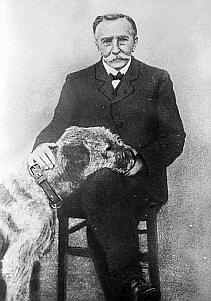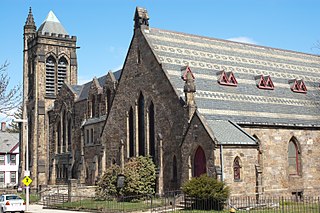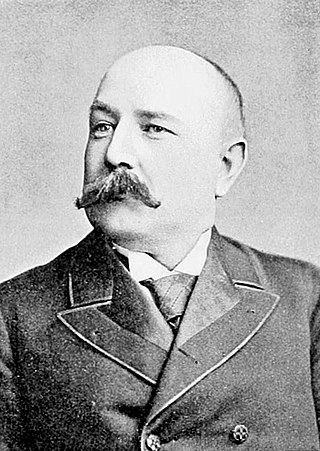
Cambridge is a city in Middlesex County, Massachusetts, in the United States. It is a suburb in the Greater Boston metropolitan area, located directly across the Charles River from Boston. The city's population as of the 2020 U.S. census was 118,403, making it the most populous city in the county, the fourth-largest in Massachusetts, behind Boston, Worcester, and Springfield, and ninth-most populous in New England. The city was named in honor of the University of Cambridge in Cambridge, England, which was an important center of the Puritan theology that was embraced by the town's founders.

This timeline of the telephone covers landline, radio, and cellular telephony technologies and provides many important dates in the history of the telephone.

Newton Highlands is one of the thirteen villages within the city of Newton in Middlesex County, Massachusetts, United States. The Newton Highlands Historic District includes residential and commercial businesses back to the late 19th century.

Newton Lower Falls, Massachusetts is one of the thirteen villages within the city of Newton in Middlesex County, Massachusetts, United States. The commercial area extends across the river into Wellesley, Massachusetts, where it is known as Wellesley Lower Falls, where a majority of the retail businesses are.

The National Register of Historic Places is a United States federal official list of places and sites considered worthy of preservation. In the state of Massachusetts, there are over 4,300 listings, representing about 5% of all NRHP listings nationwide and the second-most of any U.S. state, behind only New York. Listings appear in all 14 Massachusetts counties.

Spring Hill is the name of a ridge in the central part of the city of Somerville, Massachusetts, and the residential neighborhood that sits atop it. It runs northwest to southeast, roughly bounded by Highland Avenue, Somerville Avenue, Elm Street, and Willow Avenue. Summer Street runs along the hill's crest.

Alewife Brook Parkway is a short parkway in Cambridge and Somerville, Massachusetts. It is listed on the National Register of Historic Places. It begins at Fresh Pond in Cambridge, and heads north on the east bank of Alewife Brook, crossing into West Somerville and ending at the Mystic River on the Medford town line, where it becomes Mystic Valley Parkway. The entire length of Alewife Brook Parkway is designated as part of Massachusetts Route 16 (Route 16), while the southernmost sections are also designated as part of Route 2 and U.S. Route 3 (US 3). It is managed by the Department of Conservation and Recreation with the Massachusetts Department of Transportation responsible for bridge maintenance.

Newton Centre station is a light rail station on the MBTA Green Line D branch, located in the Newton Centre village of Newton, Massachusetts. A former commuter rail station, it was converted for light rail use and reopened on July 4, 1959, along with the rest of the line. The 1891-built station and express office are part of the Newton Railroad Stations Historic District, which was placed on the National Register of Historic Places in 1976.

The Old Corner Bookstore is a historic commercial building located at 283 Washington Street at the corner of School Street in the historic core of Boston, Massachusetts. It was built in 1718 as a residence and apothecary shop, and first became a bookstore in 1828. The building is a designated site on Boston's Freedom Trail, Literary Trail, and Women's Heritage Trail.

The Boston–Edison Historic District is a neighborhood located in Detroit, Michigan. It consists of over 900 homes built on four east-west streets: West Boston Boulevard, Chicago Boulevard, Longfellow Avenue and Edison Avenue, stretching from Woodward Avenue in the east to Linwood Avenue in the west. It is one of the largest residential historic districts in the nation. It is surrounded by Sacred Heart Major Seminary to the west, the Arden Park-East Boston Historic District and the Cathedral of the Most Blessed Sacrament to the east, and the Atkinson Avenue Historic District to the south. The district was designated a Michigan State Historic Site in 1973 and listed on the National Register of Historic Places in 1975.

Charles Street African Methodist Episcopal Church is an historic African Methodist Episcopal Church at 551 Warren Street in Boston, Massachusetts. The current church building was built in 1888 by J. Williams Beal and added to the National Register of Historic Places in 1983.

The Eliot Congregational Church is a historic Congregational church at 56 Dale Street, at the corner of Walnut Avenue in the Roxbury neighborhood of Boston, Massachusetts.

The First Universalist Church is a historic Universalist Church building at 125 Highland Avenue in Somerville, Massachusetts. The Romanesque church building was built between 1916 and 1923 to a design by Ralph Adams Cram, and is the only example of his work in Somerville. The building was listed on the National Register of Historic Places in 1989. It is currently owned by the Highland Masonic Building Association, and is the home of King Solomon's Lodge AF & AM, the builders of the Bunker Hill Monument.

The Charles Adams-Woodbury Locke House is an historic house in Somerville, Massachusetts. The Greek Revival house was built about 1840 for a Boston leather merchant and was one of the first residences of a commuter, rather than a farmer, in the Winter Hill neighborhood of the city. The house was listed on the National Register of Historic Places in 1989.

The Charles Williams House is a historic house in Somerville, Massachusetts. The 2+1⁄2-story wood frame Italianate house was built c. 1848 for Charles Williams, a hat dealer. The central projecting section has a Palladian window on the second floor, above a recessed entranceway where the door is surrounded by sidelight and transom windows. It is one of a small number of surviving Italianate homes in the city, and is one of the oldest of that style.

The Mystic Water Works, also called the Mystic Pumping Station, is a historic water works at Alewife Brook Parkway and Capen Street in Somerville, Massachusetts. Built in 1862–65 by the city of Charlestown, it is a significant example of a mid-19th century waterworks facility. The building has been listed twice on the National Register of Historic Places. The first, in 1989, is part of the city of Somerville's listings, and was made under the name "Mystic Water Works". The second is part of an umbrella listing covering the entire historic water works system of Greater Boston, and was made in 1990, listed as the "Mystic Pumping Station".

The Philemon Russell House is a historic house in Somerville, Massachusetts. Philemon Robbins Russell was a farmer who owned 50 acres (20 ha) of apple orchards near Russell Street. This land was converted to house lots for development by Captain Gilman Sargent in 1845 creating Orchard Street, Russell Street and Cottage Place. His house, built 1845, is one of the best-preserved side-hall Greek Revival farmhouses in the city. It was moved to the current location from somewhere else. According to the Somerville Journal, page 6, a fire occurred that badly damaged the upper portion of the house. The cause was a mystery and the estimated damage was $2,000. The Boston Daily Globe reported the first took place on On February 26, 1905.

Hartwell and Richardson was a Boston, Massachusetts architectural firm established in 1881, by Henry Walker Hartwell (1833–1919) and William Cummings Richardson (1854–1935). The firm contributed significantly to the current building stock and architecture of the greater Boston area. Many of its buildings are listed on the National Register of Historic Places.

George Fullington Loring (1851–1918) was an architect from Boston, Massachusetts.

Parker, Thomas and Rice and Parker & Thomas were architectural firms formed in the early 20th century by partners J. Harleston Parker, Douglas H. Thomas, and Arthur W. Rice.
























